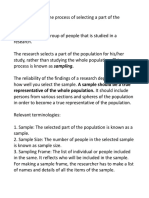0 ratings0% found this document useful (0 votes)
81 views3 Data Sampling, Collection and Testing Powerpoint
Data sampling involves selecting a representative subset of data to analyze patterns and trends. It is useful for large datasets and reduces costs. Common sampling plans include simple random sampling, stratified random sampling, and cluster sampling. Data collection gathers information from relevant sources and can be primary like surveys or secondary like published reports. Data testing experiments to develop theories through fieldwork and surveys. Quantitative research uses mathematical models to analyze numeric data collected through statistical methodology.
Uploaded by
Ryana Rose CristobalCopyright
© © All Rights Reserved
Available Formats
Download as PPTX, PDF, TXT or read online on Scribd
0 ratings0% found this document useful (0 votes)
81 views3 Data Sampling, Collection and Testing Powerpoint
Data sampling involves selecting a representative subset of data to analyze patterns and trends. It is useful for large datasets and reduces costs. Common sampling plans include simple random sampling, stratified random sampling, and cluster sampling. Data collection gathers information from relevant sources and can be primary like surveys or secondary like published reports. Data testing experiments to develop theories through fieldwork and surveys. Quantitative research uses mathematical models to analyze numeric data collected through statistical methodology.
Uploaded by
Ryana Rose CristobalCopyright
© © All Rights Reserved
Available Formats
Download as PPTX, PDF, TXT or read online on Scribd
You are on page 1/ 14
Data Sampling,
Collection and testing
What is Data Sampling
• Data sampling is a statistical analysis technique that involves selecting,
manipulating, and analyzing a representative selection of data points in
order to uncover patterns and trends in a larger data collection.
• Sampling is a process whereby a researchers chooses his/her sample.
• A sample that can be defined as any subset population.
Why Data Sampling?
• Data sampling is useful with data sets that are to large to efficiently
analyze in full.
• Data sampling can also reduce cost.
• Data sampling can boost data collection.
• Data sampling is a practical method in research.
Sampling plans
• A sampling plan is simply a strategy or procedure for determining how a
sample of a population will be gathered. Some example of sampling plans:
• Simple Random Sampling.
• Stratified Random Sampling.
• Cluster Sampling.
Simple Random Sampling
• A simple random sample is one that is chosen so that any potential sample
of the same size has an equal chance of being chosen.
• A basic random sample involves drawing three names from a hat holding
all of the students' names in the class: any group of three names has the
same chance of being chosen as any other group of three names.
Stratified Random Sampling
• A Stratified Random Sampling is generated by dividing the population
into mutually exclusive sets, or strata, and then randomly selecting simple
samples from each stratum.
• After the population has been stratified, we can use simple random
sampling to generate the complete sample.
Cluster Sampling
• A Cluster Sample is a simple random sample of groups or clusters of
elements (vs. a simple random sample of individual objects).
• This technique is effective when compiling a complete list of population
members is difficult or expensive, or when the population elements are
geographically distributed.
• When cluster members are similar, cluster sampling may increase sample
error.
What is data collection
• Data collection is a process of collecting information from all the relevant
sources to find answers to the research problem, test the hypothesis (if you
are following deductive approach) and evaluate the outcomes.
• Data collection can be divided into two categories: secondary methods of
data collection and primary methods of data collection.
Primary methods of data collection
• It is a data that came from first hand data gathered by the researcher
himself.
• It is a real time data.
• Collecting data from survey, observation, experiments, questionnaire,
personal interview etc.
• This can be very expensive and very long process of collecting data.
• This type of data collection will give you accuracy and reliability.
Secondary methods of data collection
• Secondary data is a type of data that has already been published in books,
newspapers, magazines, journals, online portals etc.
• It is a past data.
• Data can come from Government publications, websites, books, journal
article, internet records etc.
• The cost of this process is economical and the time of it can be short.
Data Testing
• Data testing is the process of experimenting to build theories.
• This might involve conducting field work and/or developing appropriate
survey instruments.
• Quantitative research involves data collection that is typically numeric
and the researcher tends to use mathematical models as the methodology
of data analysis. Additionally, the researcher uses the inquiry methods to
ensure alignment with statistical data collection methodology.
References
• Biscobing, J. (2018, September 28). What is data sampling? - definition
from whatis.com. SearchBusinessAnalytics. Retrieved March 31, 2022,
from
https://www.techtarget.com/searchbusinessanalytics/definition/data-sampl
ing
• https://www.utdallas.edu/~scniu/OPRE-6301/documents/Data_Collection
_and_Sampling.pdf
You might also like
- Lecture 3 - Types of Data, Data Collection and Sampling: NotesNo ratings yetLecture 3 - Types of Data, Data Collection and Sampling: Notes5 pages
- Sampling and Data Collection: Lecture 19-20 Research Methods (Business) Isp-AhtNo ratings yetSampling and Data Collection: Lecture 19-20 Research Methods (Business) Isp-Aht6 pages
- Assignments - PG1122 Business StatisticsNo ratings yetAssignments - PG1122 Business Statistics7 pages
- Module - 2 Sample Design and Sampling-1No ratings yetModule - 2 Sample Design and Sampling-142 pages
- WEEK 2 Data Collection and Organization 335401No ratings yetWEEK 2 Data Collection and Organization 33540149 pages
- Research - Sampling Methods and TechniquesNo ratings yetResearch - Sampling Methods and Techniques7 pages
- BRM Unit 3 (The Sources and Collection of Data)No ratings yetBRM Unit 3 (The Sources and Collection of Data)9 pages
- Data Sampling For Engineering Research MethodsNo ratings yetData Sampling For Engineering Research Methods11 pages
- Lecture 1 Overview of GIS and History of GISNo ratings yetLecture 1 Overview of GIS and History of GIS60 pages
- Cable and Tensile Structures Buen Teneza Serquina SecullesNo ratings yetCable and Tensile Structures Buen Teneza Serquina Seculles36 pages
- Shell Structure Cargo Fabian Lising Ramos HannahNo ratings yetShell Structure Cargo Fabian Lising Ramos Hannah30 pages
- Introduction To Geographic Information SystemNo ratings yetIntroduction To Geographic Information System10 pages
- Statistical Analysis With Software ApplicationNo ratings yetStatistical Analysis With Software Application3 pages
- Research Methodology and Biostatistics (NCISM)_Dr. Arun Raj GR & Dr. Kavya MohanNo ratings yetResearch Methodology and Biostatistics (NCISM)_Dr. Arun Raj GR & Dr. Kavya Mohan40 pages
- Math 140 Introductory Statistics: Types of ErrorNo ratings yetMath 140 Introductory Statistics: Types of Error4 pages
- Fourth Quarter Exam - STATISTICS and PROBABILITY 2021-202280% (5)Fourth Quarter Exam - STATISTICS and PROBABILITY 2021-20224 pages
- Answer On Question 39513 - Math - StatisticsNo ratings yetAnswer On Question 39513 - Math - Statistics1 page
- Lecture 3 - Types of Data, Data Collection and Sampling: NotesLecture 3 - Types of Data, Data Collection and Sampling: Notes
- Sampling and Data Collection: Lecture 19-20 Research Methods (Business) Isp-AhtSampling and Data Collection: Lecture 19-20 Research Methods (Business) Isp-Aht
- Cable and Tensile Structures Buen Teneza Serquina SecullesCable and Tensile Structures Buen Teneza Serquina Seculles
- Research Methodology and Biostatistics (NCISM)_Dr. Arun Raj GR & Dr. Kavya MohanResearch Methodology and Biostatistics (NCISM)_Dr. Arun Raj GR & Dr. Kavya Mohan
- Fourth Quarter Exam - STATISTICS and PROBABILITY 2021-2022Fourth Quarter Exam - STATISTICS and PROBABILITY 2021-2022
































































































